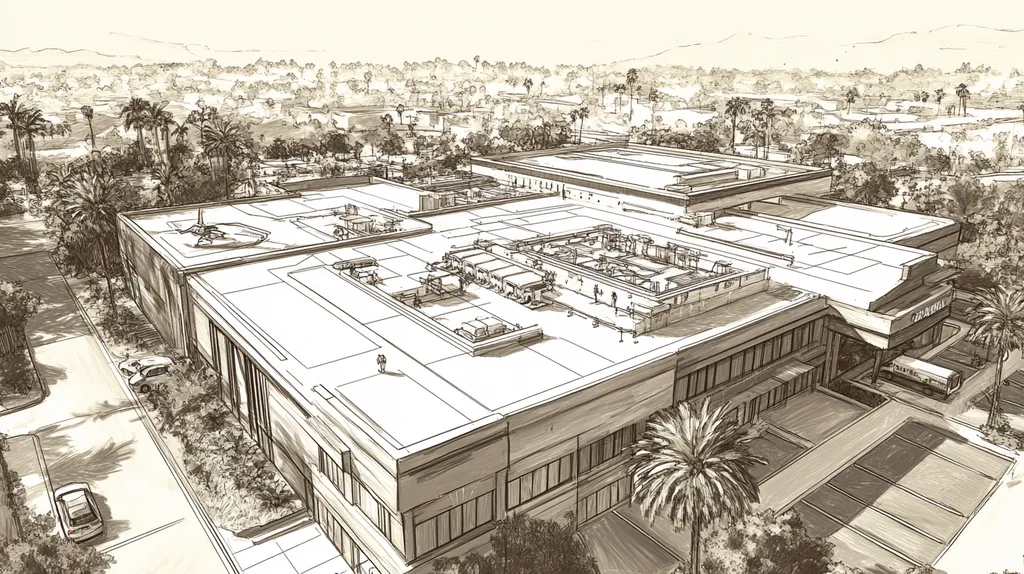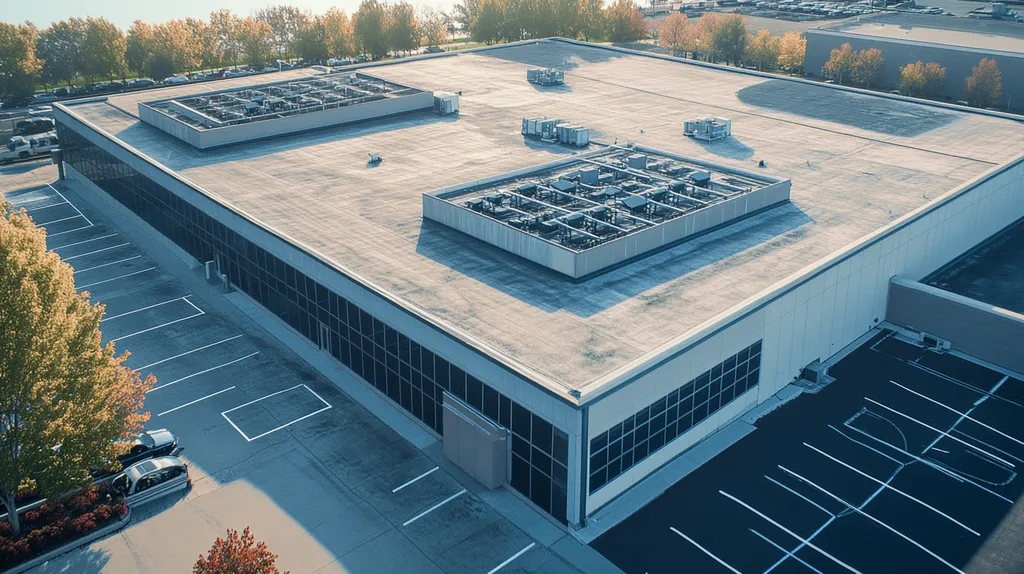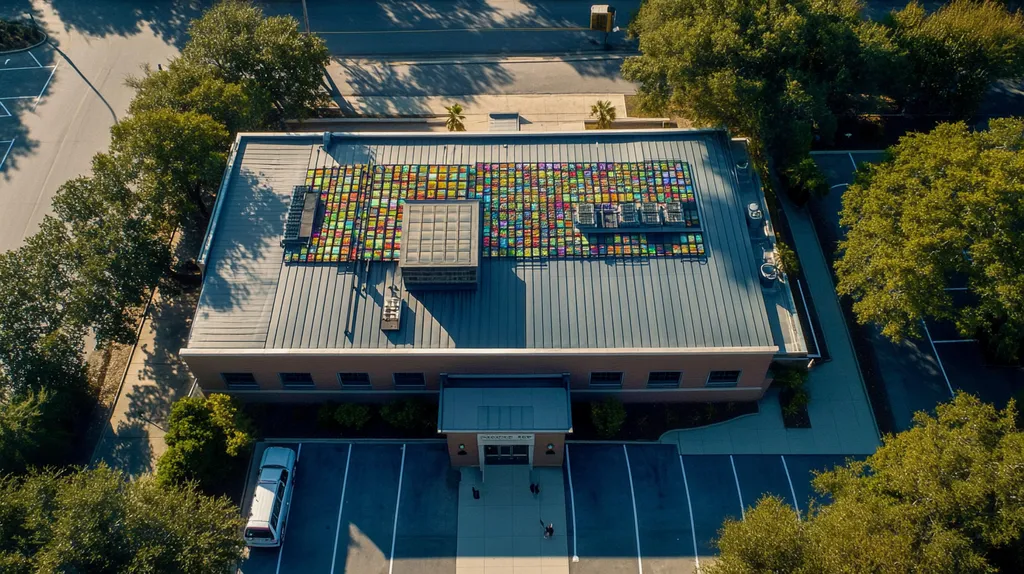Every year, commercial property owners waste millions on roof coatings that fail prematurely due to mismatched climate conditions. Industry studies show that up to 70% of coating failures stem directly from choosing products unsuitable for local weather patterns.
From scorching desert heat to coastal salt spray, climate factors critically impact how protective coatings perform and how long they last. The wrong choice can cut a coating’s lifespan in half while doubling maintenance costs.
This guide examines the essential climate considerations that determine coating success, helping property owners and facility managers make informed decisions that protect their buildings and budgets.
SECTION 1: THE BASICS EXPLAINED
Climate conditions directly impact the performance and longevity of commercial roof coatings, yet many building owners overlook this critical relationship. When exposed to extreme temperatures, humidity, and rapid weather changes, the wrong coating choice can lead to premature failure and costly repairs. Understanding how climate affects coating selection helps protect your investment and ensures optimal building performance.
What It Is (In Plain Language)
Roof coatings are specialized protective layers applied to commercial roofing systems, acting as a shield against environmental elements. These coatings create a seamless membrane that can reflect sunlight, resist water penetration, or provide other specific protective properties.
Different coating types excel in different climate conditions. Some formulations work best in hot, sunny environments by maximizing UV reflection, while others provide superior protection in regions with frequent rainfall or temperature extremes.
The coating’s primary function is to extend roof life by preventing damage from weather exposure. This protection helps maintain the structural integrity of the entire roofing system while potentially reducing energy costs.
Modern coating systems can be customized to address specific climate challenges, from extreme heat to freeze-thaw cycles. The key is matching the coating’s properties to local weather patterns.
Why It Matters (To Your Building)
The right coating choice directly impacts building maintenance costs and energy efficiency. A properly selected coating can reduce cooling costs by up to 30% in hot climates, while also preventing moisture infiltration that leads to expensive repairs.
Managers must consider humidity, high winds, and temperature extremes when selecting a roof coating. Rapid weather changes require coatings that can accommodate roof movement and maintain their protective properties. (source: FacilitiesNet)
Incorrect coating selection often leads to premature degradation, requiring frequent reapplication or complete replacement. This results in higher maintenance costs and potential disruption to building operations.
Beyond immediate protection, proper coating selection helps extend the overall lifespan of the roofing system. This long-term benefit translates to significant cost savings over the building’s lifetime.
How It Works
Roof coatings create a protective barrier through specific chemical and physical properties designed for different environmental challenges. These formulations can include reflective pigments, waterproofing compounds, or flexibility enhancers.
The coating’s effectiveness relies on proper adhesion to the roof surface and maintaining its protective properties under stress. Temperature fluctuations cause roofing materials to expand and contract, requiring coatings to remain flexible while maintaining their bond.
Advanced coating systems often incorporate multiple layers, each serving a specific protective function. The base layer ensures adhesion, while subsequent layers provide weather resistance and surface protection.
Performance monitoring helps verify that the coating continues to provide adequate protection. Regular inspections can identify early signs of coating stress or failure, allowing for timely maintenance intervention.
SECTION 2: PRACTICAL APPLICATIONS
Climate-appropriate roof coatings represent a critical investment for commercial property protection, yet many owners default to familiar solutions without considering their local weather patterns. Recent studies show that mismatched coatings can reduce roof lifespan by up to 40% while increasing energy costs by 25%. Understanding the practical applications of different coating types, optimal timing, and system interactions helps ensure maximum return on investment.
Common Uses & Examples
In hot, sunny regions, reflective coatings with high solar reflectance index (SRI) values provide essential protection against UV damage while reducing cooling loads. These coatings can decrease roof surface temperatures by up to 50-60 degrees Fahrenheit during peak summer conditions.
Coastal environments demand moisture-resistant coatings with superior adhesion properties to combat salt spray and high humidity. These specialized formulations create an impermeable barrier that prevents corrosion and extends roof life.
Areas experiencing frequent freeze-thaw cycles require coatings with exceptional elasticity to accommodate thermal movement. Low-temperature flexibility becomes crucial as standard coatings can crack and fail under these conditions.
Mountain regions with heavy snowfall need coatings that resist ice damage while maintaining watertight integrity. These formulations often incorporate additional reinforcement to handle the weight and movement of snow loads.
When You Need It Most
Roof coatings in cold climates must demonstrate specific low-temperature flexibility properties to prevent cracking, while applications in humid coastal areas require extended curing times of up to 72 hours. Proper timing of installation becomes crucial for optimal performance. (source: FacilitiesNet)
Spring applications allow coatings to fully cure before extreme summer temperatures, ensuring maximum effectiveness during peak heat. This timing also provides better adhesion due to moderate temperatures and lower humidity.
Fall installations help prepare roofs for winter challenges, particularly in regions expecting heavy precipitation. The moderate temperatures during this season create ideal conditions for proper coating adhesion and curing.
Emergency applications following severe weather events require special consideration for temperature and moisture levels. Rushing application during suboptimal conditions can compromise coating performance and durability.
Interactions With Other Systems
Roof coatings directly impact HVAC efficiency by reducing heat transfer through the roof assembly. A properly selected coating can decrease air conditioning loads by 10-20% during summer months.
Building envelope performance improves when coatings work in conjunction with insulation systems. The combined effect can enhance overall thermal resistance and moisture control.
Drainage systems benefit from smooth, properly applied coatings that promote positive water flow. This reduces ponding water and minimizes stress on gutters and downspouts.
Solar panel efficiency increases when paired with reflective roof coatings, as lower roof temperatures improve photovoltaic performance. This synergy can boost solar energy production by 5-10% annually.
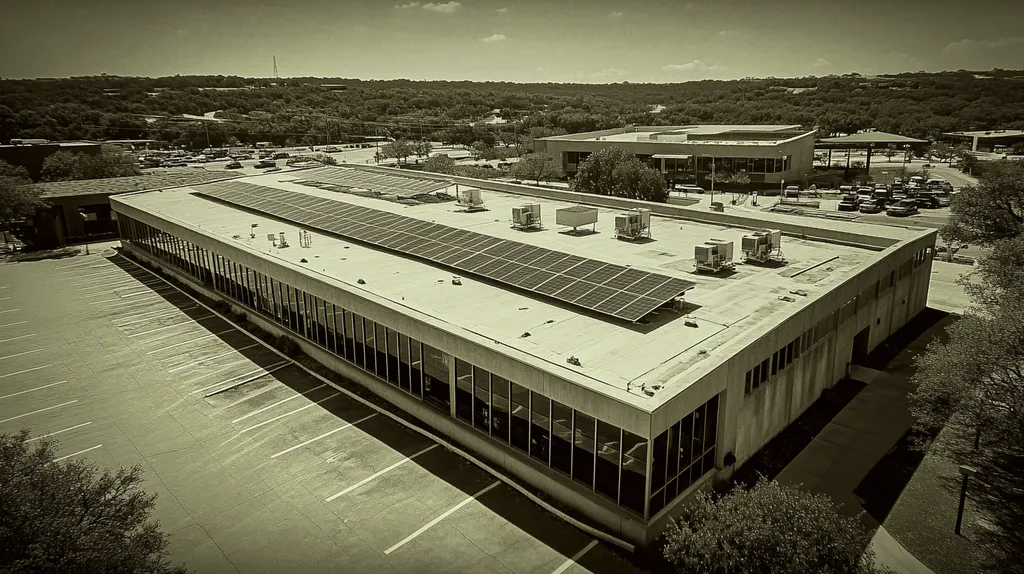
SECTION 3: KEY TERMINOLOGY DECODED
Technical roofing terminology often creates confusion that leads to costly mistakes in coating selection and application. When facility managers misinterpret specifications or misunderstand performance metrics, they risk choosing products that fail prematurely or perform poorly in local conditions. Clear understanding of industry terms, measurements, and standards is essential for making informed decisions that protect both the building and the bottom line.
Essential Terms Explained
Solar reflectance represents the percentage of sunlight reflected by a coating, typically ranging from 0 to 1. A rating of 0.85 means the coating reflects 85% of solar radiation, significantly reducing cooling costs.
Thermal emittance measures how effectively a surface releases absorbed heat. Higher emittance values indicate better heat dissipation, crucial for maintaining comfortable indoor temperatures.
Tensile strength describes a coating’s ability to resist tearing under stress. This property becomes especially important in areas with high wind loads or frequent temperature changes.
Elongation percentage indicates how far a coating can stretch without breaking. Higher elongation values suggest better performance during thermal expansion and contraction cycles.
Industry Jargon Translated
Cool roof systems encompass any roofing solution designed to reflect more sunlight and absorb less heat than standard roofs. These systems can reduce peak cooling demand by 10-15% in commercial buildings.
Extreme weather conditions increasingly affect coating applications, requiring careful attention to application temperatures and curing times. Proper installation becomes critical as climate patterns become more unpredictable. (source: Giromax)
Substrate compatibility refers to how well a coating bonds with the existing roof surface. Poor compatibility often leads to adhesion failures and coating delamination.
VOC content measures the level of volatile organic compounds in coating materials. Lower VOC ratings indicate more environmentally friendly formulations that meet strict air quality regulations.
Measurement & Units Simplified
Dry film thickness (DFT) measures the final thickness of a cured coating in mils (thousandths of an inch). Most commercial coatings require 20-30 mils DFT for optimal performance.
Coverage rates indicate how many square feet one gallon of coating will cover at the specified thickness. These rates vary based on surface texture and application method.
Cure time represents the period needed for full coating hardness development. This varies from hours to days depending on temperature, humidity, and coating chemistry.
Performance life expectancy estimates how long a coating will maintain its protective properties. This measurement assumes proper installation and regular maintenance under specific climate conditions.
SECTION 4: DECISION FACTORS
Commercial roof coating selection represents a critical investment decision that directly impacts building performance and operational costs. Industry data shows that over 70% of premature roof failures stem from improper coating choices that don’t match local climate conditions. Understanding the interplay between cost, performance, and durability helps property owners avoid costly mistakes while maximizing their return on investment.
Cost Considerations
Initial coating costs typically range from $2-8 per square foot, but focusing solely on upfront pricing often leads to expensive long-term consequences. Premium coatings may cost 30-50% more initially but can double the protection period between recoatings.
Labor costs represent 40-60% of total installation expenses, making proper application crucial. Rushing installation or using undertrained crews to save money frequently results in adhesion failures and warranty violations.
Energy savings potential should factor heavily into cost calculations. High-performance reflective coatings can reduce cooling costs by 25-35% in warm climates, often paying for their premium price within 3-5 years.
Warranty coverage varies significantly between coating types and manufacturers. Premium products typically offer 15-20 year coverage compared to 5-10 years for standard coatings, providing valuable long-term protection.
Performance Trade-offs
Silicone roof coatings demonstrate superior protection against ponding water, UV rays, and extreme weather conditions through their unique flexibility and high solids content. These coatings maintain their integrity across temperatures from -40°F to 350°F, making them particularly effective in regions with dramatic climate shifts. (source: Karnak Corporation)
Reflectivity and water resistance often compete in coating formulations. While some products excel at UV reflection, they may require additional waterproofing layers for complete protection.
Wind resistance capabilities vary significantly between coating types. Products with higher tensile strength and better adhesion properties provide superior protection in high-wind zones but may sacrifice some flexibility.
Chemical resistance becomes crucial in industrial areas where air pollution or exhaust emissions contact the roof surface. Specialized formulations offer enhanced protection but may cost more or require specific maintenance protocols.
Lifespan & Durability Factors
Coating lifespan depends heavily on proper thickness application and substrate preparation. Under-applied coatings typically fail 50-70% sooner than properly applied systems, regardless of material quality.
Regular maintenance impacts longevity significantly. Simple quarterly inspections and minor repairs can extend coating life by 25-40% compared to reactionary maintenance approaches.
Environmental stress factors like freeze-thaw cycles, UV exposure, and chemical exposure accumulate over time. Premium coatings with higher solid content and better elasticity properties show 30-50% better resistance to these cumulative effects.
Surface adhesion strength determines long-term performance more than any other factor. Proper surface preparation and primer selection can double the effective lifespan of even mid-grade coating systems.
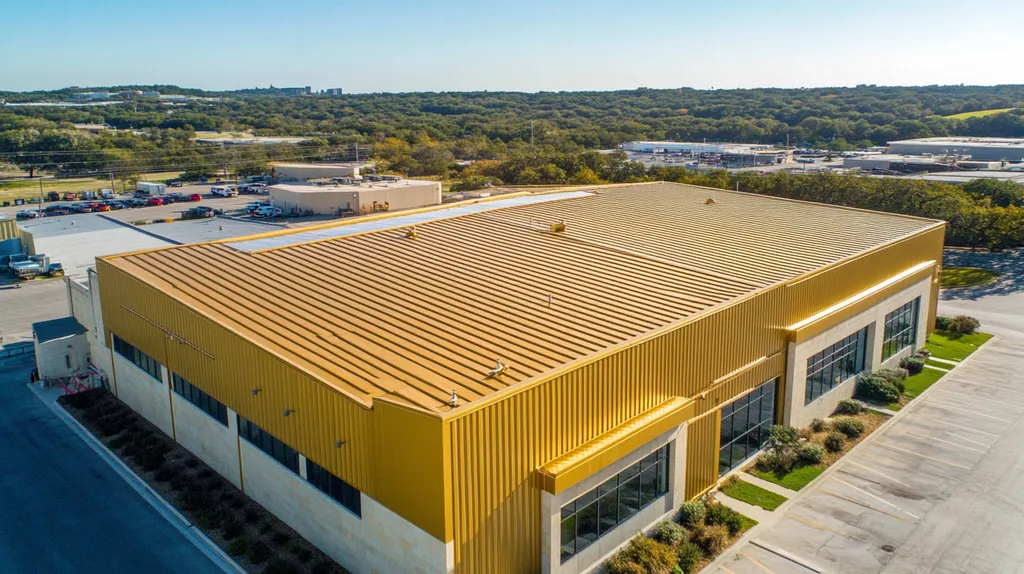
SECTION 5: COMMON CHALLENGES
Commercial roof coating failures cost property owners millions annually in repairs, energy waste, and premature replacements. Studies show that 80% of these failures stem from inadequate climate adaptation or poor installation practices. Without proper attention to warning signs and preventative measures, even premium coating systems can degrade rapidly under harsh environmental conditions.
Frequent Problems & Solutions
Silicone roof coatings have emerged as a superior solution for extreme climate challenges, maintaining their protective properties in temperatures from -40°F to 350°F. Their high solids content creates an exceptionally durable barrier against UV radiation, heavy rain, and high winds, while their superior flexibility prevents cracking and peeling. (source: Karnak Corporation)
Poor adhesion represents another common failure point, often resulting from inadequate surface preparation or incompatible coating selection. Proper surface cleaning, primer application, and material compatibility testing can prevent these costly failures.
Ponding water frequently undermines coating performance, particularly in low-slope commercial roofs. Installing additional drainage systems and selecting water-resistant coating formulations helps prevent moisture-related deterioration.
Chemical exposure from industrial emissions or air pollution can accelerate coating breakdown. Specialized chemical-resistant formulations provide enhanced protection in these environments, though they typically require specific maintenance protocols.
Warning Signs To Watch For
Surface crazing and micro-cracks often precede major coating failures. These early indicators typically appear in areas of high stress or frequent thermal cycling.
Coating thickness variations, visible as inconsistent surface texture or color, suggest application problems that can lead to premature failure. Regular thickness testing helps identify vulnerable areas before leaks develop.
Edge lifting and delamination around roof penetrations indicate adhesion failures that require immediate attention. These issues often spread rapidly if not addressed promptly.
Chalking and surface erosion signal advanced UV degradation, particularly in reflective coatings. This deterioration compromises both weather protection and energy efficiency benefits.
Preventative Approaches
Implementation of climate-specific maintenance schedules significantly reduces coating failures. Quarterly inspections should focus on high-stress areas and common failure points.
Digital monitoring systems can track coating performance metrics, enabling early detection of potential problems. These systems help optimize maintenance timing and reduce emergency repairs.
Staff training in basic coating inspection and maintenance procedures helps prevent minor issues from escalating. Regular updates on proper cleaning methods and inspection protocols ensure consistent care.
Documentation of coating performance history, including environmental exposure and repair records, supports better decision-making for future maintenance and replacement planning.
SECTION 6: NEXT STEPS & RESOURCES
The complexity of modern commercial roofing systems, combined with increasingly volatile weather patterns, makes proper coating selection more critical than ever. Industry data shows that over 65% of premature coating failures stem from misalignment between product specifications and local climate conditions. Understanding how to evaluate providers, interpret standards, and access reliable information sources can mean the difference between long-term protection and costly failures.
Questions To Ask Providers
Start by requesting detailed climate analysis specific to your building’s location. Expert providers should explain how their recommended coatings address local challenges like temperature swings, UV exposure, and precipitation patterns.
Demand performance data from similar installations in your climate zone. Quality contractors maintain detailed records of coating performance across various weather conditions and building types.
Verify the provider’s certification and training requirements for installation crews. Proper application becomes especially critical when dealing with temperature-sensitive or rapid-cure coating systems.
Request specifics about application windows and environmental limitations. Coatings with good low-temperature flexibility per ASTM D-6083 become essential in cold climates, while proper elasticity matters for regions with dramatic temperature shifts. (source: FacilitiesNet)
Industry Standards & Guidelines
ASTM International provides crucial performance benchmarks for coating selection. Their standards address critical factors like adhesion strength, elongation properties, and weather resistance.
The Cool Roof Rating Council (CRRC) offers independent ratings for solar reflectance and thermal emittance. These metrics help identify coatings best suited for high-temperature environments.
National Roofing Contractors Association (NRCA) guidelines outline best practices for coating application across different climate zones. Their recommendations account for seasonal variations and environmental challenges.
FM Global and UL standards provide important safety and performance criteria. These requirements often influence insurance rates and warranty coverage.
Further Learning Simplified
Professional organizations like BOMA and IFMA offer specialized courses on roofing technology and climate considerations. These programs provide practical knowledge for making informed coating decisions.
Manufacturer training programs deliver detailed insights into coating chemistry and performance characteristics. Many offer free online modules covering climate-specific applications.
Industry publications such as Professional Roofing and Buildings Magazine regularly feature technical articles on coating developments. Their case studies demonstrate real-world performance in various climate conditions.
Regional roofing associations conduct workshops focused on local weather challenges. These events connect property owners with experienced contractors and coating specialists.
The Bottom Line
With climate-related roof damage increasing by 35% in the past decade, selecting the right coating has never been more critical for commercial properties.
The data is clear: matching coating specifications to local environmental conditions can double system lifespan while reducing energy costs by up to 30%.
Success requires understanding how different formulations perform under specific climate stresses, from extreme temperature fluctuations to coastal salt exposure.
Property owners who invest time in climate assessment and proper coating selection protect their buildings while avoiding the 70% failure rate that comes from mismatched applications.
The future of commercial roofing depends on this crucial alignment between coating technology and increasingly volatile weather patterns.
FREQUENTLY ASKED QUESTIONS
Q. How do climate conditions affect commercial roof coatings?
A. Climate conditions significantly influence the performance and lifespan of roof coatings. Extreme temperatures, humidity, and rapid weather changes can lead to coating failures, which often result in costly repairs. Understanding the local climate is essential for selecting the appropriate coating to ensure optimal protection and longevity.
Q. What types of coatings are suitable for an industrial roof?
A. Different industrial environments require specific coatings tailored for their climate challenges. For instance, reflective coatings are ideal for hot regions, while moisture-resistant options work best in coastal areas. Understanding these needs ensures a prudent investment that extends the roof’s lifespan.
Q. What is the importance of proper coating thickness for a commercial roof?
A. Proper coating thickness is crucial for optimal long-term performance. Under-applied coatings can fail significantly sooner, resulting in leaks and other issues. Ensuring the right thickness applies underlies the durable performance of the coating and ultimately secures your roof investment.
Q. How can I identify coating failure on my commercial roof?
A. Warning signs of coating failure include surface cracks, peeling, and loss of reflectivity. Regular inspections will help identify these early indicators, preventing extensive damage and costly repairs. Catching problems early ensures better maintenance and longevity of your roof coating.
Q. What role does energy efficiency play in coating selection for commercial roofs?
A. Energy efficiency is a significant factor in coating selection, especially in warmer climates. High-performance reflective coatings can lower cooling costs by reducing heat absorption, making them a cost-effective choice. This selection can directly impact your energy expenses and overall building sustainability.
Q. What certifications should I look for in roofing coating providers?
A. Look for certifications that demonstrate expertise in coat application, such as manufacturer-specific training and installation credentials. Knowledge of building codes and material safety standards is equally crucial. Verified providers can ensure better installation and performance of your chosen roofing system.
Q. How often should I maintain my industrial roof coating?
A. Regular maintenance is vital, with quarterly inspections recommended to identify early issues. Preventative measures, like cleaning debris and addressing small cracks, can significantly extend the life of your industrial roof coating. Consistent upkeep can save you money and prevent major repairs in the future.

